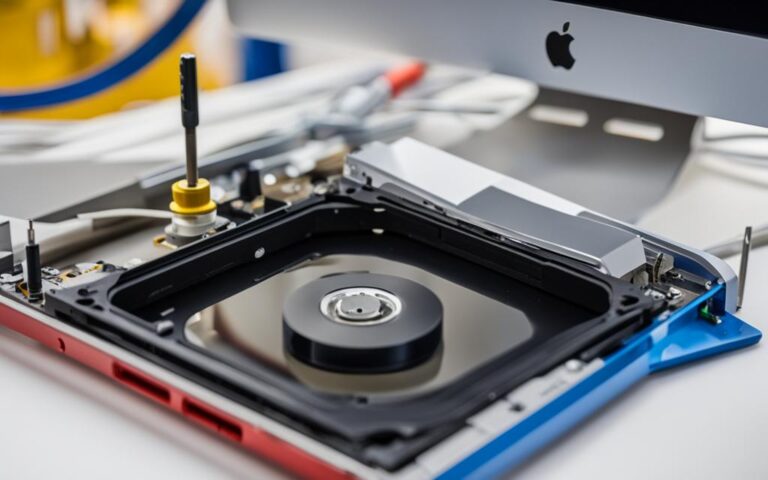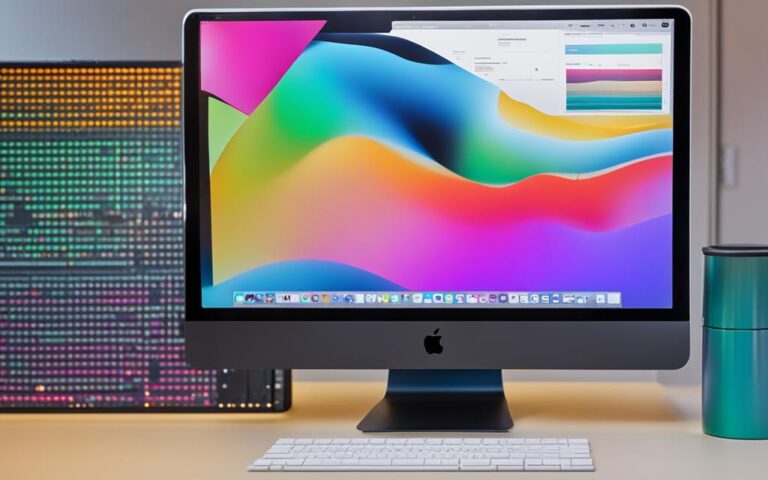iMac Display Calibration for Designers and Photographers
In today’s digital world, accurate color representation is crucial for designers and photographers who want to showcase their work in all its glory. The iMac’s stunning display offers vibrant and lifelike colors, but to ensure that the colors on your iMac screen match the colors in your creative work, iMac display calibration is essential.
Calibrating your iMac display involves adjusting the display settings to achieve precise color accuracy. By calibrating your iMac display, you can say goodbye to guesswork and achieve consistent and reliable color reproduction in your design and photography work.
Factors such as ambient light, display position, and display age can significantly impact color perception. When calibrating your iMac display, it’s important to consider these factors to ensure optimal color accuracy. With a calibrated iMac display, you can trust that the colors you see on the screen are true to life.
In this article, we’ll delve into the world of iMac display calibration and explore the factors that affect color perception on iMac displays. We’ll guide you through the calibration process and provide tips for achieving the best results. Whether you’re a professional designer or photographer or simply a creative enthusiast, this iMac display calibration guide will help you elevate the quality of your work.
Factors Affecting Color Perception on iMac Displays
When it comes to color perception on iMac displays, several factors can influence how colors are perceived. It’s important to understand and consider these factors in order to achieve accurate color representation. Let’s explore them in detail:
Ambient Light Conditions
Ambient light plays a significant role in color perception on iMac displays. The type and intensity of the lighting in your environment can create reflections on the screen and impact how colors are perceived. Bright light sources or direct sunlight can introduce unwanted glare and alter color accuracy. It’s crucial to ensure a controlled lighting environment to minimize these effects.
Position and Angle of the Display
The position and viewing angle of the iMac display can also affect color perception. Viewing the screen from different angles can result in variations in colors and contrast. It’s advisable to position the display at eye level and directly in front of you to minimize any distortions or color shifts.
Age of the Display
As iMac displays age, their color reproduction may become less accurate. Over time, the quality of the display panel may deteriorate, leading to changes in color saturation, brightness, and overall color fidelity. Regular calibration is essential to mitigate the effects of display aging and maintain consistent and accurate color representation.
“Understanding the factors that can affect color perception on iMac displays is crucial for achieving accurate and reliable color representation in design and photography work.”
| Factors | Impact on Color Perception |
|---|---|
| Ambient Light Conditions | Creates reflections and alters color accuracy |
| Display Position and Angle | Affects color variations and contrast |
| Display Age | May result in changes in color fidelity and saturation |
By calibrating your iMac display with these factors in mind, you can ensure precise and consistent color representation for your design and photography work. Now, let’s explore how to calibrate your iMac display in the next section.
How to Calibrate Your iMac Display
Calibrating an iMac display is a straightforward process that can significantly enhance the accuracy of color representation. Follow these simple steps to calibrate your iMac display:
- Open System Preferences on your Mac.
- Click on the “Displays” option.
- Select the “Color” tab.
- Click on the “Calibrate” button.
The Display Calibrator Assistant will now guide you through the calibration process, helping you adjust various display settings for optimal color accuracy.
Follow the on-screen instructions carefully, as they will prompt you to make adjustments in areas such as brightness, contrast, gamma, and white point settings. These adjustments ensure precise color representation on your iMac display.
Once you have completed the calibration process, a color profile will be created and assigned to your iMac display. This calibrated color profile will now provide accurate color representation for all your design and photography work.
Benefits of Calibrating Your iMac Display
Calibrating your iMac display offers various benefits for designers and photographers, including:
Accurate color reproduction: Calibrating your iMac display ensures that the colors you see on screen accurately match the original digital files or prints.
Consistent results: By calibrating your display, you can achieve consistency in your creative work, ensuring that the colors you choose remain consistent across different devices and outputs.
Improved productivity: When your display is calibrated, you can trust that the color decisions you make during the design or editing process will accurately translate to the final product.
Take the time to calibrate your iMac display, as it is an essential step towards achieving accurate color representation and producing high-quality creative work.
Preparing Your iMac Display for Calibration
Before calibrating your iMac display, it is important to make sure it is properly set up. Follow these steps to create optimal conditions for accurate color calibration:
- Place the display in a well-lit area, away from direct sunlight or bright light sources.
- Clean the display to remove dust and fingerprints, ensuring a clear and unobstructed view.
- Set the brightness of the display to 50% to establish a neutral starting point.
By taking these precautions, you will minimize potential distractions and interference that could impact the accuracy of the calibration process.
“Calibration is vital to ensure consistent and accurate color representation in your design and photography work. By preparing your iMac display correctly, you lay the foundation for a successful calibration process.”
Once your iMac display is properly set up and cleaned, you are ready to proceed with the calibration process, ensuring your creative work is showcased with precision and clarity.
Choosing Settings during Calibration
During the calibration process, you will have the opportunity to adjust certain settings to optimize the color accuracy of your iMac display. These settings play a crucial role in ensuring that the colors on your screen are represented as accurately as possible.
Gamut
One of the key settings you’ll encounter is the gamma, which determines the contrast of the display. A gamma setting of 2.2 is generally recommended for most graphic arts work, as it strikes a balance between preserving detail in shadows and highlights, resulting in a visually pleasing image.
White Point
Another important setting is the white point, which defines the neutral white color you see on your iMac display. Selecting the right white point is crucial for achieving accurate color representation. In most cases, choosing the “Use native white point” option is suitable as it aligns with the display’s default color temperature.
To ensure you make the best choices during calibration, simply follow the on-screen instructions provided by the Display Calibrator Assistant. It will guide you through the process, allowing you to adjust gamma and select the appropriate white point.
Best Practices for Choosing Calibration Settings
- Consider the specific requirements of your work. Depending on your industry or personal preference, you may need to experiment with different gamma settings to achieve the desired color representation.
- Ensure consistency. If you work in a team or collaborate with others, it’s crucial to choose calibration settings that align with industry standards or establish a shared calibration profile.
- Take into account the ambient lighting conditions in your workspace. If you typically work in different lighting environments, you may need to create and save multiple calibration profiles to adapt to each scenario.
- Regularly reassess your calibration settings. As your needs or workspace conditions change, it’s important to revisit the calibration process periodically to ensure ongoing color accuracy.
By carefully selecting the gamma and white point settings during calibration, you can achieve a visually stunning and accurate representation of color on your iMac display, enhancing the quality and precision of your design and photography work.
Saving and Applying the Calibration Profile
Once the calibration process is complete, you will be prompted to save the calibration profile. Assign it a descriptive name, such as “Photo Printing,” for easy identification. The calibration profile can be accessed and applied in the color settings of the iMac display. By selecting the calibration profile, you ensure that your iMac display accurately represents colours for your design and photography work.
After completing the calibration, it’s important to save the calibration profile. This ensures that the calibrated colour settings are preserved even if the iMac display settings are changed. To save the calibration profile, follow these steps:
- Go to the System Preferences on your iMac.
- Click on Displays.
- Select the Color tab.
- Click on the Calibrate button to open the Display Calibrator Assistant.
- Follow the on-screen instructions to adjust the display settings.
- Once the calibration is complete, you will be prompted to save the calibration profile.
- Assign a descriptive name to the profile, such as “Photo Printing” or “Design Work”.
Once the calibration profile is saved, you can easily access and apply it whenever you need to adjust the iMac display’s colour settings. This ensures that you have consistent and accurate colour representation for your design and photography work.
Benefits of Saving the Calibration Profile
Saving the calibration profile offers several benefits:
- Consistency: By applying the calibration profile, you maintain consistent colour representation across different projects and media.
- Accuracy: The saved calibration profile ensures that the iMac display accurately reproduces colours, so you can rely on it for precise editing and printing.
- Efficiency: Instead of recalibrating the display each time, you can simply apply the saved calibration profile, saving you valuable time.
- Flexibility: With multiple saved calibration profiles, you can easily switch between settings to accommodate various design and photography needs.
Applying the Calibration Profile
Applying the saved calibration profile is a straightforward process. Here’s how you can do it:
- Go to the System Preferences on your iMac.
- Click on Displays.
- Select the Color tab.
- Choose the calibration profile you want to apply from the list of saved profiles.
- The iMac display’s colour settings will be adjusted accordingly based on the selected calibration profile.
By saving and applying the calibration profile, you ensure that your iMac display consistently delivers accurate and vibrant colours. This is crucial for achieving the desired visual impact in your design and photography projects.
Hardware Color Calibration for Advanced Needs
For professionals and those with advanced color calibration needs, hardware color calibrators can provide more precise results. These devices, such as Spyder or X-Rite ColorMunki, detect and adjust colors on the iMac display. They factor in ambient lighting conditions and create detailed color profiles tailored to specific needs. Hardware calibrators are particularly useful for photographers who want their display colors to match their prints. Consider using a hardware calibrator for the highest level of color accuracy.
Benefits of Hardware Calibrators
Hardware calibrators offer several advantages over software-based calibration:
- Precision: Hardware calibrators use advanced sensors to detect color values directly from the display, ensuring highly accurate calibration.
- Consistency: By creating custom color profiles, hardware calibrators ensure consistent color representation across different software and platforms.
- Speed: Hardware calibrators often have automated processes that streamline the calibration process, saving valuable time.
- Flexibility: With hardware calibrators, users can create multiple custom color profiles for different needs, such as print or web design.
Using a hardware calibrator gives professionals the confidence that their iMac display accurately reproduces colors, providing a solid foundation for their design and photography work.
“Hardware color calibrators are essential tools for achieving precise and consistent color accuracy on iMac displays. They enable professionals to confidently produce work that accurately represents their artistic vision.” – Jane Miller, Professional Photographer
Comparing Popular Hardware Calibrators
Here is a comparison table of two popular hardware color calibrators:
| Calibrator | Features | Price |
|---|---|---|
| Spyder X Elite | Advanced color accuracy Ambient light monitoring Custom display calibration |
£249 |
| X-Rite ColorMunki Photo | Professional-level calibration Printer profiling Ambient light control |
£399 |
While both calibrators offer advanced features, the Spyder X Elite provides an affordable option for users who prioritize color accuracy, while the X-Rite ColorMunki Photo is ideal for photographers who require additional printer profiling capabilities.
Investing in a hardware color calibrator is a wise choice for professionals and anyone seeking the highest level of color accuracy on their iMac display. By utilizing these devices, creators can ensure their work is represented with precision, consistency, and true-to-life colors.
Conclusion
Calibrating your iMac display is essential for achieving accurate color representation in your design and photography work. By considering factors such as ambient light, display position, and age, and following the calibration process, you can ensure consistent and precise color reproduction.
Whether you choose to use the built-in calibration tools or invest in hardware calibrators like Spyder or X-Rite ColorMunki, the ultimate goal is to achieve optimal color accuracy on your iMac display. Taking the necessary steps to calibrate your iMac display will greatly enhance the quality of your creative work.
Remember, a calibrated display provides you with the confidence that the colors you see on your screen will be accurately represented in your final designs or prints. Don’t underestimate the importance of display calibration in bringing your artistic vision to life.












